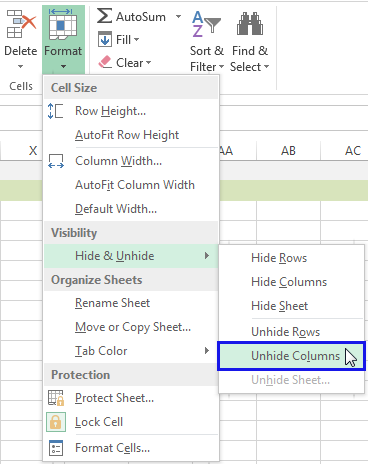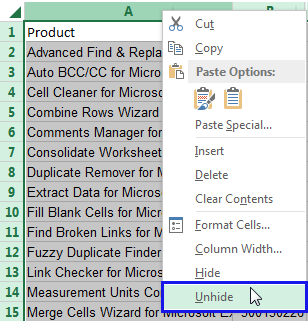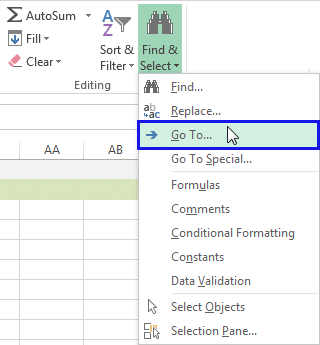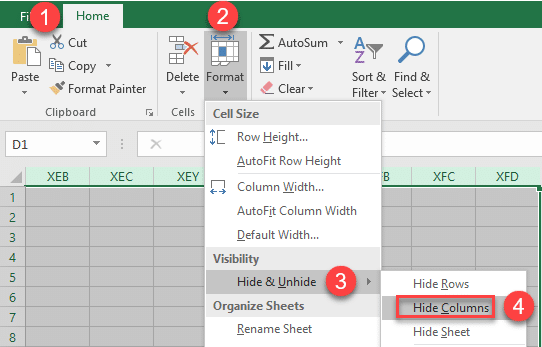Excel, the ubiquitous spreadsheet software, is a powerful tool for organizing and analyzing data. However, sometimes certain columns mysteriously disappear from view, leaving users puzzled about how to retrieve them.
Fortunately, unhiding columns in Excel is a straightforward process that can save you time and frustration. In this article, we will explore effortless strategies for unhiding columns in Excel, ensuring seamless data management.
Table of contents
About the Microsoft Excel
Microsoft Excel, developed by Microsoft Corporation, is one of the most widely used spreadsheet applications globally.
Since its inception in the mid-1980s, Excel has evolved from a simple data organization tool to a powerful application capable of handling complex calculations, data analysis, and visualization.
Its user-friendly interface and versatile functionalities have made it indispensable in various fields, ranging from finance and engineering to education and research.
Key Features
#1. Spreadsheet Creation and Organization
At its core, Excel provides a grid interface where users can organize data into rows and columns. This tabular format simplifies tasks like creating lists, budgets, and schedules. Excel’s intuitive design allows users to input, edit, and format data seamlessly.
#2. Formulas and Functions
Excel is renowned for its vast library of built-in formulas and functions. From basic arithmetic operations to complex statistical and financial calculations, Excel’s formulas automate computations, saving time and reducing the margin for errors. Users can create custom formulas to suit specific needs, enhancing the application’s flexibility.
#3. Data Analysis and Visualization
Excel thrives in data analysis. It offers various tools for sorting, filtering, and summarizing data. Pivot tables enable users to analyze large datasets and extract valuable insights.
Additionally, Excel’s charting capabilities allow users to create visually appealing and informative charts, graphs, and dashboards, making data interpretation more accessible.
#4. Data Integration and Import/Export
Excel seamlessly integrates with other Microsoft Office applications and numerous data sources. Users can import data from databases, external spreadsheets, and web sources, enabling comprehensive analysis.
The ability to export Excel data to different file formats enhances compatibility and facilitates collaborative work.
#5. Macros and Automation
Excel allows users to automate repetitive tasks using macros, which are sequences of instructions that can be recorded and replayed. This automation feature enhances productivity and reduces manual workload, especially for tasks involving extensive data manipulation.
Read this article: How to Tie a Bow: Crafty Decorations
How Different Industries Use the Excel
- Finance and Accounting: Financial analysts use Excel for budgeting, forecasting, and financial modeling. Accountants rely on Excel for tasks like ledger management and creating financial statements.
- Business and Marketing: Business analysts utilize Excel for market research, trend analysis, and sales forecasting. Marketers employ the application to track campaign performance and analyze customer data.
- Education and Research: Educators use Excel for grading, data analysis in research projects, and creating interactive learning materials. Researchers benefit from Excel’s statistical functions and charting tools for data visualization.
- Engineering and Science: Engineers and scientists utilize Excel for data analysis in experiments, simulations, and research. Its computational capabilities assist in solving complex equations and analyzing engineering data.
- Project Management: Project managers employ Excel for creating Gantt charts, tracking project progress, and managing resources. Excel’s organizational features aid in project planning and execution.
How to Unhide Columns in Excel
Before exploring methods to reveal hidden columns, it is expedient to understand the reasons behind their disappearance. Columns in Excel might be intentionally or unintentionally hidden.
Users often hide columns to concentrate on specific data or to create a neater spreadsheet appearance. Fortunately, these columns can be effortlessly displayed again when required.
So, here’s how:

The Ribbon menu in Excel provides a user-friendly way to manage hidden columns. Here’s how you can use it to unhide columns effortlessly.
- Select the Range: Begin by selecting the columns surrounding the hidden column. For example, if column C is hidden, select columns B and D.
- Navigate to the Home Tab: Click on the ‘Home’ tab located in the Ribbon menu at the top of the Excel window.
- Find the ‘Format’ Option: In the ‘Cells’ group, look for the ‘Format’ option. Click on it to reveal a dropdown menu.
- Unhide Columns: From the dropdown menu, hover your cursor over ‘Hide & Unhide’ to expand the submenu. Here, you will find options to hide and unhide columns. Select ‘Unhide Columns’ to make the hidden columns reappear.

Another quick method to unhide columns is by using the right-click menu. Here’s how you can do it.
- Select Adjacent Columns: Similar to the first method, select the columns adjacent to the hidden column.
- Right-click on the Selection: Right-click on the selected columns to open the context menu.
- Choose ‘Unhide’: In the context menu, you will find the ‘Unhide’ option. Click on it, and Excel will immediately reveal the hidden columns.
Method 3: Using the Name Box

The Name Box in Excel can also be utilized to unhide columns efficiently. Here’s how:
- Select the Adjacent Columns: Once again, select the columns on either side of the hidden column.
- Click on the Name Box: The Name Box is located to the left of the formula bar. Click on it to activate the text box.
- Enter the Column Reference: In the Name Box, enter the reference of the hidden column.
- Press Enter: After entering the column reference, press Enter. Excel will automatically select the hidden column, making it visible again.
Did you know you can make money online? Read this article: How to Sell Feet Pics: A Guide to Earning Money Online
FAQs
Unhiding columns in Excel for Mac follows similar steps as in Excel for Windows. Select adjacent columns, right-click, and choose “Unhide” from the context menu. Alternatively, use the Ribbon menu by going to Format > Hide & Unhide > Unhide Columns.
If the Unhide option is greyed out, it means there are no hidden columns in the selected range. Ensure you have selected the correct adjacent columns, and if needed, expand your selection to cover the hidden columns.
Yes, you can use the keyboard shortcut ‘Ctrl’ + ‘Shift’ + ‘0’ (zero) to unhide columns. Select the adjacent columns to the hidden ones and press this shortcut to unhide them.
Conclusion
Revealing hidden columns in Excel is a fundamental skill crucial for efficient data handling. By becoming proficient in these straightforward techniques, individuals can effectively oversee their spreadsheets, eliminating any confusion caused by hidden columns.
Whether you opt for the Ribbon menu, the right-click menu, or the Name Box method, these approaches offer versatile ways to swiftly and effectively unhide columns. Armed with these techniques, you can effortlessly tackle hidden columns in your Excel documents, saving valuable time and ensuring continued productivity.






